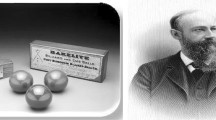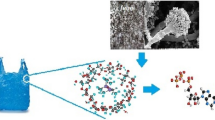Abstract
Three hydrocarbon degrading microorganisms were isolated from the soil samples collected from the storage sites of low viscosity spindle oil containers and identified on the basis of morphological and biochemical characteristics as Aeromonas hydrophila, Bacillus subtilis and Staphylococcus aureus. The study has revealed high ability of these microorganisms for oil biodegradation. The results have indicated that all isolates had the potential to breakdown the hydrocarbon. The most efficient bacteria among these examined was Aeromonas hydrophila which biodegraded almost all tested hydrocarbon giving a treatment percentage of 98% within 30 days which was considered as the perfect period for degradation. Also, a small scale was designed to treat the spindle oil with the using of oxidation process and all the tested organic materials were biodegraded in a treatment percentage of 100% within retention time of 20 days.







Similar content being viewed by others
References
Abbawi SA, Hassan MS (1990) Environmental Engineering, water analysis. Dar Al-Hekma for printing and publishing, Mosul
Alsulami AA, Altaee AM, Alkanany FN (2014) Improving oil biodegradability of aliphatic crude oil fraction by bacteria from oil polluted water. AFR J Biotechnol 13(11):1243–1249
Al-Wasify RS, Hamed SR (2014) Bacterial biodegradation of crude oil using local isolates. IJSB. https://doi.org/10.1155/2014/863272
Atlas RM (1984) The fate of petroleum in marine ecosystem. Petrol Microbiol. 272, USA
Basuki W (2017) Biodegradation of used synthetic lubricating oil by Brevundimonas diminuta AKL 1.6. Makara J Sci 21(3):136–142
Bhattacharya M, Biswas D, Sana S, Datta S (2015) Biodegradation of waste lubricants by a newly isolated Ochrobactrum sp. C1. 3 Biotech 5(5):807–817
Cerqueira VS, Hollenbach EB, Maboni F, Vainstein MH, Camargo FAO, Peralba MCR, Bento FM (2011) Biodegradation potential of oily sludge by pure and mixed bacterial cultures. Bioresource Technol 102(23):11003–11010
Del' Arco JP, Franca FP (2001) Influence of contamination levels on hydrocarbon biodegradation in sandy sediment. Environ Pollut 110:515–519
Friello DA, Mylroie JR, Chakrabarty AM (2001) Use of genetically engineered multi-plasmid microorganisms for rapid degradation of fuel hydrocarbons. Int Biodeter Biodegr 48(1–4):233–242
Fritsche W, Hofrichter M (2008) Investigation of the bioremediation potential of aerobic zymogenous microorganisms in soil for crude oil biodegradation. Biotechnol 11(2):144–149
Garrity GM, Bell JA, Lilburn TG (2004) Bergey's Manual of systematic bacteriology, 2nd edn. Springer, New York
Ghazali FM, Abdul Rahman RN, Salleh AB, Basri M (2004) Biodegradation of hydrocarbons in soil by microbial consortium. Int Biodeter Biodegr 54:61–67
Hamzah A, Rabu A, Azmy RF, Yussoff NA (2010) Isolation and characterization of bacteria degrading sumandak and south angsi oils. Sains Malays 39(2):161–168
Ibrahim HMM (2016) Biodegradation of used engine oil by novel strains of Ochrobactrum anthropi HM-1 and Citrobacterfreundii HM-2 isolated from oil-contaminated soil. 3 Biotech 6(2):226
Janbandhu A, Fulekar MH (2011) Biodegradation of phenanthrene using adapted microbial consortium isolated from petrochemical contaminated environment. J Hazard Mater 187:333–340
Magot M (2005) Indigenous microbial commsystemies in oil fields. In: Ollivier B, Magot M (eds) Petroleum Microbiology. ASM, Washington, pp 21–34
Malik ZA, Ahmed S (2012) Degradation of petroleum hydrocarbons by oil field isolated bacterial consortium. AFR J Biotechnol 11(3):650–658
Mukred AM, Hamid AA, Hamzah A, Yusoff WMW (2008) Development of three bacteria consortium for the bioremediation of crude petroleum-oil in contaminated water. J Biol Sci 8(4):73–79
Naser RB (2000) Bacteriological and genetic study of hydrocarbons utilizing Pseudomonas Spp. MSc. Sci. College. Baghdad Uni. Iraq
Pérez Silva RM, Rodriguez AA, Oca GM, Moreno DC (2006) Biodegradation of Crude Oil by Pseudomonas aeroginosa at 18 strains. Technologia Quimica 26(1):70–77
Prince RC, Nash GW, Hill SJ (2016) The biodegradation of crude oil in the deep ocean. Mar Pollut Bull 111(1–2):354–357
Shekhar SK, Godheja J, Modi DR (2015) Hydrocarbon bioremediation efficiency by five indigenous bacterial strains isolated from contaminated soils. Int J Curr Microbiol App Sci 4(3):892–905
Silverstein RM, Webster FX, Kiemle DJ (2005) Spectrometric Identification of Organic Compounds, 7th edn. John Wiley and Sons, New York
Thomas JM, Ward CH, Raymond RL, Wilson JT, Loehr RC (1992) Bioremediation. In: Joshua L (ed) Encyclopedia of Microbiology, vol 1. Academic Press, New York, pp 369–385
Turkey AM, Barzani KK, Suleiman AA (2018) Molecular assessment of accessory gene regulator (agr) quorum sensing system in biofilm forming Staphylococcus aureus and study of the effect of silver nanoparticles on agr system. Iran J Microbiol 10(1):14–21
Ugur A, Ceylan O, Aslim B (2012) Characterization of Pseudomonas Spp. from seawater of the southwest coast of Turkey. J Biol Environ Sci 6(16):15–23
Waltman WD, Shotts EB, Hsu TC (1982) Enzymatic characterization of Aeromonas hydrophila complex by the API ZYM system. J Clin Microbiol 16(4):692–696
Wang D, Lin J, Lin J, Wang W, Li S (2019) Biodegradation of petroleum hydrocarbons by Bacillus subtilis BL-27, a strain with weak hydrophobicity. Molecules. https://doi.org/10.3390/molecules24173021
Wang Z, Fingas M, Shu YY, Sigouin L, Landriault M, Lambert P (1999) Quantitative characterization of PAHs in burn residue and shoot samples and differentiation of pyrogenic PAHs from petrogenic PAHs the 1994 mobile burn study. Environ Sci Technol 33(18):3100–3109
Wua N, Zonga Z, Feib Y, Mab J, Guob F (2018) Thermal degradation of aviation synthetic lubricating base oil. Petrol Chem 58(3):250–257
Acknowledgements
The authors would like to thank the Ministry of Science and Technology- Directorate of Hazardous Wastes Treatment and Disposal/research center laboratories, and CRDF-Global, for supporting this work. Authors also appreciate the efforts of associate Professor Dr. Ahmed A. Suleiman and associate Professor Dr. Asra’a Adnan Abdul-Jalil from the Department of Biology, College of Science, University Of Anbar, for their assistance in the molecular part.
Author information
Authors and Affiliations
Corresponding author
Ethics declarations
Conflict of interest
Sufyan Mohammed Shartooh declares that he has no conflict of interest. Author Mohammed Fadhil Abood declares that he has no conflict of interest. Haidar Kadum Yahob declares that he has no conflict of interest.
Informed consent
Informed consent has been obtained. The study has been approved by the Environment and Water directorate, Iraqi Ministry of Science and Technology [Ethical Approval/ 2015/ (T.B.M 25/740)].
Additional information
Communicated by Erko Stackebrandt.
Publisher's Note
Springer Nature remains neutral with regard to jurisdictional claims in published maps and institutional affiliations.
Rights and permissions
About this article
Cite this article
Shartooh, S.M., Abood, M.F. & Yakob, H.K. Biodegradation of low viscosity spindle oil causing environmental pollution. Arch Microbiol 202, 2189–2196 (2020). https://doi.org/10.1007/s00203-020-01938-4
Received:
Revised:
Accepted:
Published:
Issue Date:
DOI: https://doi.org/10.1007/s00203-020-01938-4




